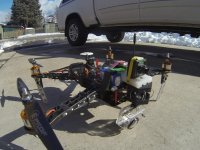No experience with the FS stuff but, based on what I read, yes. That said, all radio range questions depend heavily on how clear the LOS is between the TX and RX antennas. This is even more true as one ascends in frequency, i.e. 900M vs 1.2G vs. 2.4G vs. 5.8G. This how FRS handi-talkie manufacturers even remotely justify their claims of a "23 mile range" (Yes, I've seen this in print!) FRS radios are 500mW power, yep, one half of a watt, with a garbage antenna system to boot! 23 mile range ??? Maybe between the top of the Matterhorn and a neighboring peak, but certainly not even remotely at ground level with trees, buildings, and other obstructions. It ain't gonna happen, not in a real world environment. So your FS goggle set-up may work like a champ at 5 miles as long as there's a clear LOS between you and the aircraft, yep, very believable. But, duck your bird behind a row of trees, or a building, and *boop*, no pic, and you're flying blind. All the hoopla about CP antennas, (IBCrazy, etc.) is to help fight this very thing. Does it help ? Probably, but it's no magic bullet. The sheer physics of the situation wins everytime.

